PaleoFest Speaker Lineup
2024 Speakers:
- Matthew Carrano
Smithsonian National Museum of Natural History, dinosaurs - Julia Clark
University of Texas-Austin, Birds - Tony Fiorillo
New Mexico Museum of Natural History, dinosaurs and tracks - Abdullah Gohar
Mansoura University, Oklahoma State University, basilosaurus whales - Andrew Heckert
Appalachian State University, Triassic Microverts - Thomas Holtz
SUN University of Maryland, Theropods - Katherine Jordan
University of Nebraska, Trilobites (*pending) - Victoria McCoy
University of Wisconsin-Milwaukee, Biomolecules in amber - Dalton Meyer
Yale University, Morrison Lizards - Maria Valleja-Poreja
University of Florida, Frogs - Daniel Vidal
University of Chicago Post Doc, Sauropods - Paige Wilson
University of Washington, Paleobotany - Nathan Smith
Natural History Museum of Los Angeles, Antarctica – KEYNOTE - Kathleen Rust
SAT University of Kansas, paleoanthropology - Katie Tremaine
Montana State University, Triceratops
PaleoFest 2024 Speaker Lineup
Our lineup of esteemed speakers encompasses a diverse array of expertise within the field of paleontology, promising enlightening discussions and groundbreaking insights into the world of prehistoric life. From the towering dinosaurs that once roamed the land to the delicate biomolecules preserved in amber, Paleofest offers a unique opportunity to explore the wonders of our planet’s past.
Join us as we uncover the mysteries of ancient ecosystems, uncovering the secrets of long-extinct creatures and the environments they inhabited. Get ready to be inspired, educated, and awestruck by the marvels of paleontological research at Paleofest!

Matt Carrano
Talk title:
Taking the Smithsonian’s fossil halls into the twenty-first century
Abstract:
From 2013 to 2019, the Smithsonian’s National Museum of Natural History completely dismantled and renovated its century-old fossil halls. The largest such project in the museum’s history, it involved dozens of curators, educators, and exhibit designers alongside more than a hundred other specialists. As lead curator, Matthew Carrano was tasked with bringing together experts on all aspects of the history of life on Earth, as well as reimagining the iconic dinosaurs and other fossils on display. In this talk, he will outline the history of the museum’s fossil exhibits and provide a behind-the-scenes view of how the new hall came to be, while detailing the journeys of some of the museum’s most famous fossil denizens.
Bio:
Matthew Carrano has been Curator of Dinosauria at the Smithsonian Institution since 2003, where he was lead curator for the Deep Time exhibition (2013-2019). He received his B.Sc. from Brown University (1991) and his M.Sc. (1995) and Ph.D. (1998) from the University of Chicago. Matthew studies dinosaur evolution, Mesozoic ecosystems, and the dinosaur fossil record. He has published dozens of scientific papers and collected fossils in the US, Madagascar, Chile, Zimbabwe, and India. He has served the Society of Vertebrate Paleontology, the Paleontological Society, and the Paleobiology Database, and co-edited the journal Paleobiology.

Julie Clark
Talk Title:
A Dinosaur’s Roar
Abstract:
Based on movies and other media, many of us imagine that a dinosaur may have roared like a lion or a tiger. What if that was all wrong? By examining birds as living descendants of dinosaurs, Dr. Julia Clarke shares how ancient dinosaurs may have produced sound and what that tells us about modern-day birds.
Bio:
Julia Clarke is a paleontologist and evolutionary biologist at the University of Texas-Austin who studies birds and dinosaurs to better understand major transitions in the history of life. An insatiable curiosity has led Dr. Clarke to far-flung regions of the world, from Peru to New Zealand to Mongolia and Antarctica, and to collaborate with a range of experts outside of paleontology, such as developmental biologists, geneticists and engineers.
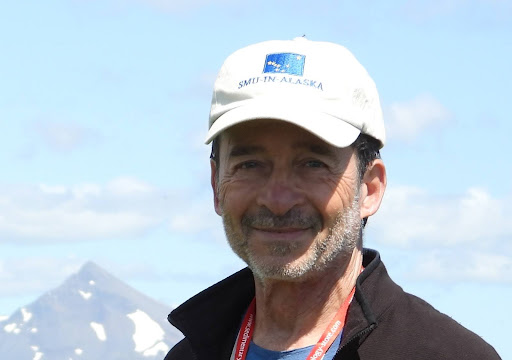
Tony Fiorillo
Anthony R. Fiorillo, Executive Director, New Mexico Museum of Natural History & Science, Albuquerque,
New Mexico.
Title:
The Dinosaurian World of Aniakchak National Monument, southwestern Alaska: a fossil resource of global importance
Abstract:
The first discovery of any dinosaur remains in a US National Park Service unit in Alaska occurred in 2001 in Aniakchak National Monument and Preserve. The record consisted of the track of a pes impression, or track made by the foot of a hadrosaur (duck-billed dinosaur) and an associated manus impression, or track made by a hand. Subsequent work has shown the original track discovery was not unique, and that the coastal exposures of the Cretaceous Chignik Formation in Aniakchak National Monument and Preserve contain a remarkable number of tracks, as over 100 such localities are now recorded. The track fauna is dominated by tracks of hadrosaurs, but armored dinosaurs, meat- eating dinosaurs, and two kinds of fossil birds are also represented. Further, because of the limited faulting, the several hundred meters of section found along this coastal set of exposures provide a remarkably complete look at an ancient high-latitude dinosaurian ecosystem and are of outstanding universal value.
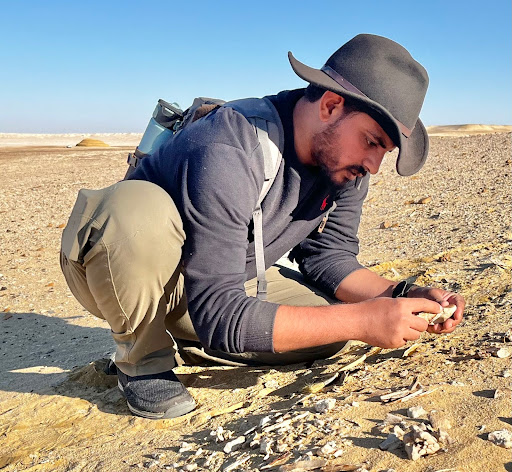
Abdullah Gohar
Short Bio:
Abdullah Gohar is a member of the Mansoura University Vertebrate Paleontology Center (MUVP) and is currently pursuing his PhD at Oklahoma State University. His primary research area is the evolution of marine mammals, with a focus on the earliest cetaceans.
Abdullah has actively participated in various paleontological field projects at MUVP, contributing to the discovery of new vertebrate fossils in Egypt. He has also led and co-led the naming and describing of two ancient whale species unearthed from Egypt. These include the amphibious four-legged whale, Phiomicetus anubis, and the fully aquatic Tutcetus rayanensis, recognized as the smallest basilosaurid whale ever found.
Alongside his research work, Abdullah has co-led MUVP’s teaching and training program, expanding the center’s impact in Egypt and the Middle East.
Title:
Egyptian Eocene cetaceans revealing insights into whale evolution
Abstract:
The evolution of whales, from small, four-legged terrestrial mammals to today’s ocean-going leviathans, stands as one of the most remarkable transitions in mammalian evolution. Archaeocetes, or early whales, offer evidence of this transformative journey from land to water. For over 150 years, Egyptian archaeocetes have captivated scientists, making substantial contributions to our understanding of whale evolution. Recent work conducted by the Mansoura University Vertebrate Paleontology Center (MUVP), in collaboration with international colleagues, has led to the identification and naming of two new extinct whales: Phiomicetus anubis and Tutcetus rayanensis. Both species, originating from the Fayum Depression, provide unique insights into whale evolution. Phiomicetus anubis, a 43-million-year-old four-legged amphibious protocetid whale, stands as the most basal protocetid whale known from Africa. The species received its name after the ancient Egyptian canine-headed god “Anubis,” inspired by its lethal bite due to the notable size of its temporal muscles. Moreover, P. anubis provides the first clear evidence of the coexistence of different early archaeocete families outside of the Indo-Pakistan region. On the other hand, Tutcetus rayanensis is a 41-million-year-old fully aquatic basilosaurid whale. Named after King Tutankhamun, it reflects its small size and subadult status. Tutcetus represents one of the earliest stages of complete aquatic adaptation in whales. It also holds the title of the smallest basilosaurid ever discovered, and it stands as one of the oldest records of the basilosaurid family, shedding light on the early rise to dominance and dispersal of whales. Ongoing work aims to conduct histological studies of Egyptian archaeocetes to provide deeper insights into whale evolution.

Andy Heckert
Talk Title:
Tiny Triassic fossils that address big evolutionary topics: Microvertebrates from the Lower Triassic of South Africa
Abstract:
Vertebrate microremains, commonly called microvertebrate fossils, are typically bones, scales, and teeth less than 1 cm maximum dimension. While by definition incomplete remains of larger animals, they still provide great insight into much of vertebrate diversity, and are particularly important to understand in terms of the evolution of the bulk of vertebrate diversity. An exceptionally rich (>100,000 fossils) microvertebrate assemblage from Driefontein, South Africa is of latest Early Triassic age, and therefore in prime position to yield information on both the recovery from the end-Permian extinction event and document the rise of archosauromorph reptiles, including early relatives of dinosaurs and other animals that would dominate the rest of the Triassic. Amongst the thousands of coprolites, bones, teeth, and scales are tiny representatives of sharks, bony fish, and diverse tetrapods, including “amphibians,” synapsids, and diapsids. These include rare records of enigmatic taxa such as Palcrodon and early representatives of advanced cynodonts and archosauromorphs.
Bio:
Andrew Heckert is a professor of Geological & Environmental Sciences at Appalachian State University, where he has taught courses on the history of the planet and its fossil record since 2005. Before that he was the geoscience collections manager at the New Mexico Museum of Natural History & Science in Albuquerque, NM. He has done field work on Triassic vertebrates throughout the American Southwest as well as in Argentina and South Africa, and traveled to museums on five tectonic plates to study Triassic fossils. He holds a BS from Denison University and MS and PhD from the University of New Mexico.
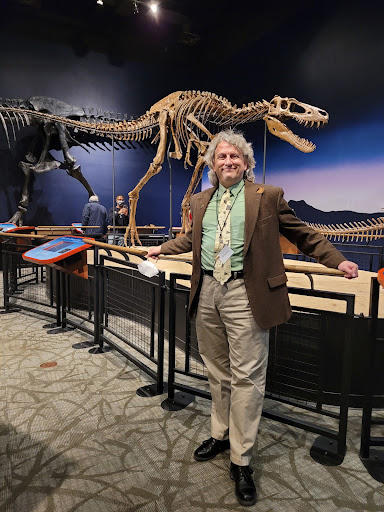
Thomas Holtz
Talk Title:
“From Tots to Titans: How Dinosaur Ontogeny Affects Ecosystem Structure and Diversity, and Why Dinosaurs Are Not Mammal-Analogues”
Abstract:
Large dinosaurs differ from large mammals in several critical fashions. Firstly, all hatchling dinosaurs are small, while new-born placental mammals can be much larger. Secondly, dinosaurian clutch size remains large even at the largest body sizes, while mammalian litter size decreases to an average of 1-2 among large mammals. Additionally, while mammalian young are often provisioned by the parents until nearly full-sized, at least some dinosaurs appear to have lived lives independently of their parents in changing ecological roles during growth. These distinctions, as well as a possibly different net resource base, may explain differences in species diversity and size distributions between dinosaurian and mammalian faunal assemblages.

Katherine Jordan-Burmeister
Talk Title: Mysteries of the Ancient Oceans: What the Devonian Can Tell Us About Today?
Abstract:
Despite increases in technology, the oceans on Earth remain a place of unexplored mystery. We
have never fully conquered the depths and are still actively discovering marine life to this day! In
an age of rapid faunal loss driven by human impacts and climate change, how can we go about
understanding our oceans? The answer: we can look at our past to understand our present. Part of paleontology is looking at long-term patterns across time, especially times of change. For example, we can look at ancient oceans in the Devonian Period (420-359 million years ago) and observe how animals (and plant life) adapted to a time defined by turnover and climatic changes. The Devonian Period was a time of major drama: plants and animals were moving onto land for the first time in Earth’s history. However, at the same time, oceanic creatures were undergoing widespread extinction—but why? What does the move to land, climatic shifts, and plate tectonics mean for the ill-fated ocean creatures of the Devonian Period? In addition, what about this time of ecological change can help us understand about our modern world and oceans? Tune in to see the story play out!
Biography:
Kat Jordan-Burmeister is a PhD Candidate at the University of Nebraska-Lincoln. Originally from Maine, Kat developed a love of the ocean early in life. She comes from a family of lobster
fishermen and grew up handling creatures that came up in her grandfather’s fishing traps. In college, Kat pursued biology hoping to go into forensics. She was always fascinated in mysteries and trying to solve them! However, midway through college, she decided her love of the ocean, prehistoric life, and the mysteries of the Earth were what she wanted to pursue. Kat got her Master’s in Ecology and Evolution at the University of Calgary in 2019. From there, she has been completing her Ph.D. in Earth Sciences. Her dissertation focuses on speciation, extinction, and biogeographic patterns of the last group of trilobites, the proetids, of the Devonian Period. In her free time, Kat is a prolific reader of science fiction, loves to crochet, and loves to play video games with her family.
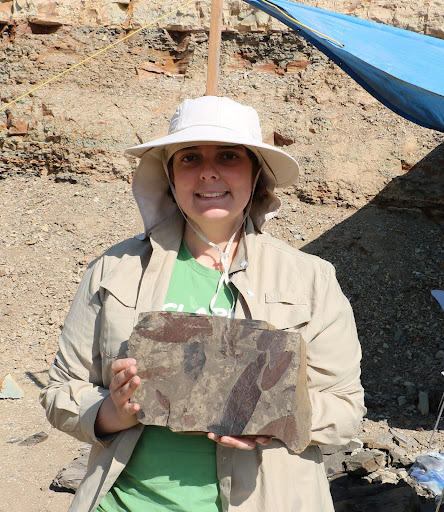
Victoria McCoy
Title:
Biomolecules in amber: a window into a unique mode of fossilization
Bio:
Victoria (Tory) McCoy is an Assistant Professor of Paleontology at the University of Wisconsin-Milwaukee. She received her BS in geosciences from Michigan State University in 2010, and her PhD in geology from Yale University in 2015. She has a wide range of research interests, but currently focuses primarily on fossil plant defenses against herbivory (including amber), and the Late Carboniferous Mazon Creek fossil site.

Dalton Meyer
Talk Title: The Not-So-Terrible Lizards: Using Jurassic Fossils to Explore the Origins and Evolutions of Modern Squamates
Abstract:
Lizards (including snakes and amphisbaenians) are the most diverse group of living tetrapods, are found around the globe (except at far high latitudes), and have an evolutionary history dating back to the dawn of the dinosaurs. However, our understanding of the origins of the major modern groups of lizards has been obscured by a relatively poor fossil record, and conflict between results obtained with different data sources. Recently, our work on fossils from the Late Jurassic Morrison Formation of the western US has revealed three new species of lizards from a key time in their evolutionary history. Our new stem-gecko and stem-skinks illustrate that lizards began to diversify at a time when they were outnumbered by their closest relatives, the rhynchocephalians. They also provide a glimpse into the anatomy of the earliest members of the modern lizard fauna, highlighting major differences from their modern relatives, as well as the origin of some key features. Adding the fossil lizards from the Solnhofen limestone (of Archaeopteryx fame) to our analyses has recontextualized several of these famous fossils in the context of the squamate tree of life. Our analyses paint a new picture of the diversity of the diversity of jurassic lizards that dovetails with other research groups highlighting a previously unknown diversity and disparity of early squamates during the mesozoic.
Bio:
Dalton is a PHD candidate at Yale University studying the evolution of lizards. He is originally from Loveland, Colorado, and spent his childhood visiting the Denver Museum of Nature and Science. Before his time at Yale, Dalton began his undergraduate education at Montana State University before completing it at Colorado State University (go rams!). He has also spent time working with the Denver Museum of Nature and Science as a teen science scholar, and spent a summer working with the paleontological team at Badlands National Park.
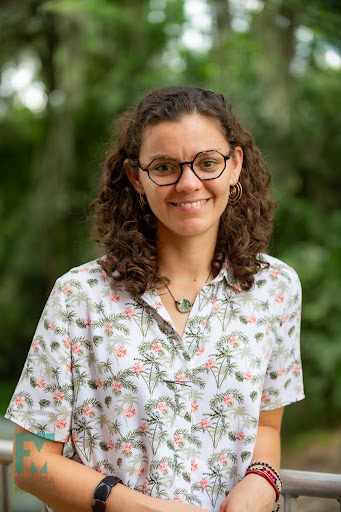
Maria Valleja-Poreja
PhD Candidate, Florida Museum of Natural History
Title:
Frogs in time: new perspectives on the evolution of anurans in North America.
Abstract:
Frogs and toads (Anura) and their recent ancestors are present in North America’s fossil record since the Late Triassic of Arizona. But with a fragmentary and sparse fossil record, we know little about changes in their diversity, form, size, and distribution or how they responded to climate change or extinction events. To close this gap in knowledge, we are studying different fossil frog communities in North America. I will review the major highlights in the evolutionary history of Anura with a specific focus on the North American fossil record. Further, this talk will discuss new findings from fossil communities from the Late Cretaceous Hell Creek Formation from Montana, and the Late Oligocene of Florida. The study of these fossil communities provides new insights into the taxonomic composition of North America at different geologic times, contributes to understanding anuran biogeography, and allows us to test new methodologies for estimating body size in fossil frogs. All of this enables us to better understand the anuran fossil record and better integrate it with our knowledge of living frog diversity.
Bio:
I am a Colombian vertebrate paleontologist and a PhD Candidate in the University of Florida and the Florida Museum of Natural History. I am interested in the morphological evolution, diversification and distribution and fossil record of small vertebrates, particularly frogs. My current research is focused on the evolution of fossil frog communities in North and Central America. I am committed to making science more inclusive, equitable and approachable. I like to talk about frogs, their weird life cycles, and their fossils. In Spanish or English, in classrooms, museums and parks, frogs and fossils are always a good excuse to talk about what scientists do and don’t do.

Daniel Vidal
BIO:
I am a vertebrate paleontologist working in dinosaur evolution, functional anatomy and virtual techniques. I graduated at the Universidad Autónoma de Madrid (Spain) and I did my PhD studies at UNED (Spain’s National University of Distance Education) on the evolution of sauropod dinosaurs postcranial biomechanics. Currently I am a Marie Curie postdoctoral fellow awardee at the University of Chicago. I find adventure and discovery among the most thrilling aspects of paleontology, and new technologies exciting for the amount of new information they can provide from fossils. My approach is therefore trying to master traditional and novel approaches to be the most complete paleontologist I can be. My first papers focused on the unusual dermal armor (bones within skin) of titanosaurian sauropods. During my dissertation I developed virtual paleontology models to reproduce the motion of the neck of living giraffes to model those of sauropod dinosaurs while I developed collaborations on reconstructing the skeletal and muscular anatomy of theropod dinosaurs like Concavenator, Pelecanimimus or Spinosaurus. My current line of research focuses on the evolution of sauropod and theropod dinosaurs from West Africa.
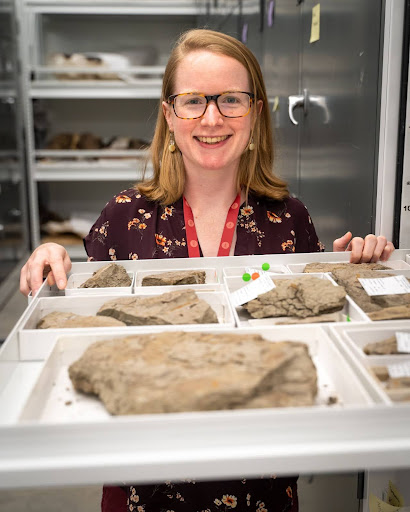
Paige Wilson
Talk Title: Plants that Outlived Dinosaurs: Impact of the Cretaceous-Paleogene Mass Extinction on Plant Communities
Bio:
I am a paleobotanist! I study plant fossils to understand what our Earth looked like millions of years ago and provide us with tools to predict what Earth might look like into the future. I received my bachelor’s degree from Dartmouth College where I studied Eocene-Oligocene mammal fossil assemblages from South Dakota and developed a passion for rocks, fossils, and all things ancient Earth. I pivoted to study plant fossils for my PhD because plants give a unique window into the past: they are the base of terrestrial ecosystems, can be used to infer paleoclimate, and they give a broad ecological view of ancient communities. For my PhD dissertation in Earth and Space Sciences at the University of Washington, I collected and studied over 7,500 plant fossils from northeastern Montana (Hell Creek and Fort Union Formations). I investigated the taxonomy of these communities, the impact of the Cretaceous-Paleogene mass extinction on plant species, and the ecological impact of mass extinctions. Today, I use this specialized knowledge of plant fossils as the Paleobotany Collections and Lab Manager at the Burke Museum of Natural History and Culture in Seattle, WA. I manage over 75,000 plant fossil specimens including macrofossils (i.e., leaves, fruits, wood) and microfossils (i.e., pollen and phytoliths) as well as modern reference collections. I help researchers access our collections, advise on research projects ongoing at the University of Washington, manage the physical care and data of all our plant fossil specimens, maintain safety and equipment in our lab facilities, and continue to study Cretaceous-Paleogene age fossils through field and museum work. Above all, I work with our community to learn more about the natural world!

Nathan Smith
Talk Title:
“Early Dinosaur Evolution: from the Paleo-Equator to the Pole”
Abstract:
The Late Triassic witnessed the origin of modern vertebrate groups and a major mass extinction, yet the early diversification of dinosaurs remains one of the most poorly known events of vertebrate evolution. Renewed interest in dinosaur origins has challenged classical hypotheses of rapid transition to dinosaur-dominated faunas in the Late Triassic, as well as previous assumptions of cosmopolitan biogeographic patterns in early Mesozoic tetrapods. The Hayden Quarry at Ghost Ranch, New Mexico has contributed significantly to these questions, having yielded over 30,000 Late Triassic (Norian, ~212Ma) vertebrate fossils since 2006, including multiple new species. The discovery of non-dinosauriform dinosauromorphs such as Dromomeron romeri from the Hayden Quarry established that a diverse array of dinosaur “precursors” were contemporaries of dinosaurs for a substantial part of the Late Triassic, and
revealed that the transition to dinosaur-dominated communities was diachronous across Pangea. The dinosaur component of the Hayden Quarry has shown that many features unique to the avian body plan were already in place early in dinosaur evolution, and that the perplexing dichotomous pattern of herbivorous sauropodomorph diversity at high- vs. low latitudes may have been driven by climate and plant community instability in tropical latitudes during the Late Triassic. Similarly, research on dinosaurs from the Early Jurassic Hanson Formation of Antarctica is also revising our understanding of early dinosaur phylogeny and biogeography. The saurischians Cryolophosaurus and Glacialisaurus fill major anatomical and temporal gaps in early dinosaur phylogeny, and helped establish the paraphyly of the classical groups Coelophysoidea and Prosauropoda, two major clades that span the End Triassic mass extinction event. The recent discovery of new species of Antarctic sauropodomorphs supports prevalent dispersal across Pangea during the early Mesozoic, and provides new opportunities for testing biogeographic hypotheses for the group’s early history. Separate from these insights into dinosaur evolution, our field projects and research in Ghost Ranch and the central Transantarctic Mountains have provided unique opportunities for mentoring and training future geoscientists, and for broadening public understanding of paleontology through impactful museum exhibits and programming.
Speaker Bio:
Dr. Nathan Smith supervises the Dinosaur Institute staff and conducts research on dinosaur
evolution. He holds a B.A. from Augustana College, M.S. from the University of Iowa, and
Ph.D. from the University of Chicago, and was a professor at Howard University before joining
the Natural History Museum of LA County in 2015. Fieldwork has taken Nate to Antarctica,
Argentina, China, and the western USA. His research is funded by the National Science
Foundation, and focuses on the evolution of Triassic–Jurassic dinosaurs and the use of
comparative methods in paleontology. The origin and diversification of dinosaurs represents one
of the most poorly known events of vertebrate evolution, and Nate’s work in Ghost Ranch, New Mexico and Antarctica has filled major gaps in our understanding of early dinosaurs and their world. His Antarctic field program is featured in the 3-D IMAX® movie, “Dinosaurs of
Antarctica”, and he co-curated the traveling exhibit “Antarctic Dinosaurs”.

Kathleen Rust
Kathleen Rust, PhD Candidate
University of Kansas Biodiversity Institute and department of Ecology and Evolutionary Biology
Talk Title:
“Reading the Fossil Record: how fossils from China reveal the origin and evolutionary history of the last nonhuman primate in North America before the arrival of humans”
Abstract:
Ekgmowechashala is a poorly documented but very distinctive primate known only from the late
early Oligocene (~30 million years ago) of western North America. Because of its unique dental
anatomy and spatiotemporal isolation, the evolutionary and biogeographic affinities
of Ekgmowechashala have long been debated. Here, I will present the oldest known fossils
of Ekgmowechashala from the Brown Siltstone Beds of the Brule Formation, White River Group
of western Nebraska and a new fossil species, Palaeohodites, from the Nadu Formation (late
Eocene) in the Baise Basin of Guangxi Zhuang Autonomous Region in southern China. Despite
being widely separated through time and space, I will show how these two fossil species are
closely related. Specifically, I will explain results from two independent phylogenetic analyses
that unequivocally demonstrate that North American Ekgmowechashala and Palaeohodites are
sister species that belong to a larger group of southern Asian adapiform primates called
ekgmowechashalids. The discovery of Palaeohodites not only elucidates the origin of
Ekgmowechashala as an immigrant taxon from Asia, but also helps fill the considerable
disparity in dental evolution between Ekgmowechashala and other extinct ekgmowechashalids
known from southern Asia. I will also explain how this study of Ekgmowechashala and
Palaeohodites underscores the fundamental role of southern Asia as a refugium for multiple
primate groups during the cooler and drier climatic regime that prevailed after the
Eocene–Oligocene transition. The colonization of North America by Ekgmowechashala
corresponds to an example of the Lazarus effect, whereby a taxon (in this case, the order
Primates) reappears suddenly in the fossil record after a lengthy hiatus.
Biography:
Kathleen Rust is a PhD Candidate researching early primate evolution and systematics at the
University of Kansas Biodiversity Institute and department of Ecology and Evolutionary Biology.
She received a B.A. (2012) with high honors in anthropology and German from the University of
Texas at Austin. She earned an M.A. in anthropology (2018) from Hunter College City University
of New York. Her master’s thesis work involved collecting data from fossils to investigate the
phylogenetic affinities and origins of sivaladapids – an extinct group of adapiform primates. Her
thesis research suggests a new possible evolutionary scenario for the origins and evolution of
Sivaladapidae. During her graduate studies in New York City, she was recruited as a biological
anthropology educator at the American Museum of Natural history (AMNH). As a doctoral
student, she conducts paleontological fieldwork with her colleagues, collecting mammalian
fossils from late Paleocene rock formations in Wyoming and Eocene rock formations in Turkey.
She continues to study and publish on adapiform systematics, and her dissertation research
investigates the purported evolutionary trade-off between vision and olfaction in early primate
evolution. By studying the fossils of primates and genomes of living mammals, her research
explores morphological integration of the maxillofacial skeleton to test if changes in the facial
anatomy reflect this trade-off between the visual and olfactory sensory systems in the fossil
record of primates.
Katie Tremaine
Coming Soon
